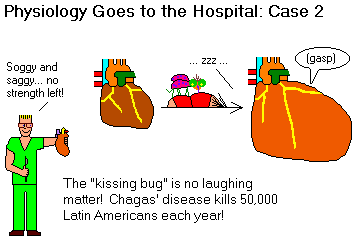
Carlos, a 27 year old immigrant from rural El Salvador, previously in robust good health, experienced palpitations and dizziness while playing soccer, and abruptly lost consciousness. He awoke after two minutes and said he felt fine.felt well. At the hospital, he was noted to be lean, muscular, and asymptomatic. Pulse was 56, respirations 18, BP 130/60. The heart was enlarged, with a forceful left ventricular lift, occasinal premature beats, and an S3 gallop. EKG showed a normal rhythm with rate 63, a right bundle branch block, and an R-wave axis of -86o. A Holter monitor showed 539 single supraventricular ectopic beats and 5644 ventricular ectopic beats. There were multiple runs of accelerated idioventricular rhythm, with an 8-beat run of ventricular tachycardia at a rate of approximately 200 beats per minute. Ultrasound showed dilatation of the left ventricle, with an internal dimension of 58 mm (normal 37 to 53), and an estimated ejection fraction of 0.52. Doppler showed slight mitral, tircuspid, and pulmonic regurgitation. 99mTc scan using albumin microspheres revealed no shunt. A 99mTc-labelled RBC scan showed a a dilated left ventricle without regional wall-motion abnormalities. The left ventricular ejection fraction was 0.67. Cardiac catheterization revealed:
Right ventricular biopsy was consistent with Chagas's cardiomyopathy, and serology showed antibodies against T. cruzi. Carlos's rhythm disturbances were reduced but not eliminated by administration of procainamide, and he died suddenly a few months later.
You will see these pictures (MGH 32-1993) in class.

What are the normal heart sounds?
What is a reasonably healthy ejection fraction? How might a drop affect you?
What are the other normal values which would have been obtained on catheterizing an average, healthy person?
While we're talking about this... what might we have found if we'd catheterized the rest of the soccer team?
What is a ventricular lift?
What is an "idioventricular" rhythm?
What produces ventricular tachycardia? HINT: Can you relate this to re-entry?
What determines the axis of depolarization? WHY is this a subject of so much interest?
Sketch his Holter monitor strip!
Do you know anyone who has occasional "PVC"'s? What's "within normal limits"? What can make them worse? Better? Should you care?
Why might a damaged cell be prone to generate rhythm disturbances?
Why do you think he had his first symptoms playing soccer? HINT: What is the effect of epinephrine on cardiac ion channels?
Why use radioactive albumin microspheres to search for a right-to-left shunt?
Why use radioactive red cells to make a movie of the heart?
What is "preload"? What has happened to it here?
What is "afterload"? What has happened to it here?
What determines cardiac contractility?
If we were to use this man's heart to test Starling's law, what might we discover?
Can you account for the mitral valve insufficiency?
If this man had survived, what might have been warnings of impending congestive heart failure?
What do you see on histology to account for the lack of contractility?
Main "Physiology Goes to the Hospital" Page
Case 1
Case 3
Case 4
Case 5
Ed's Home Page
Bryan's Home Page